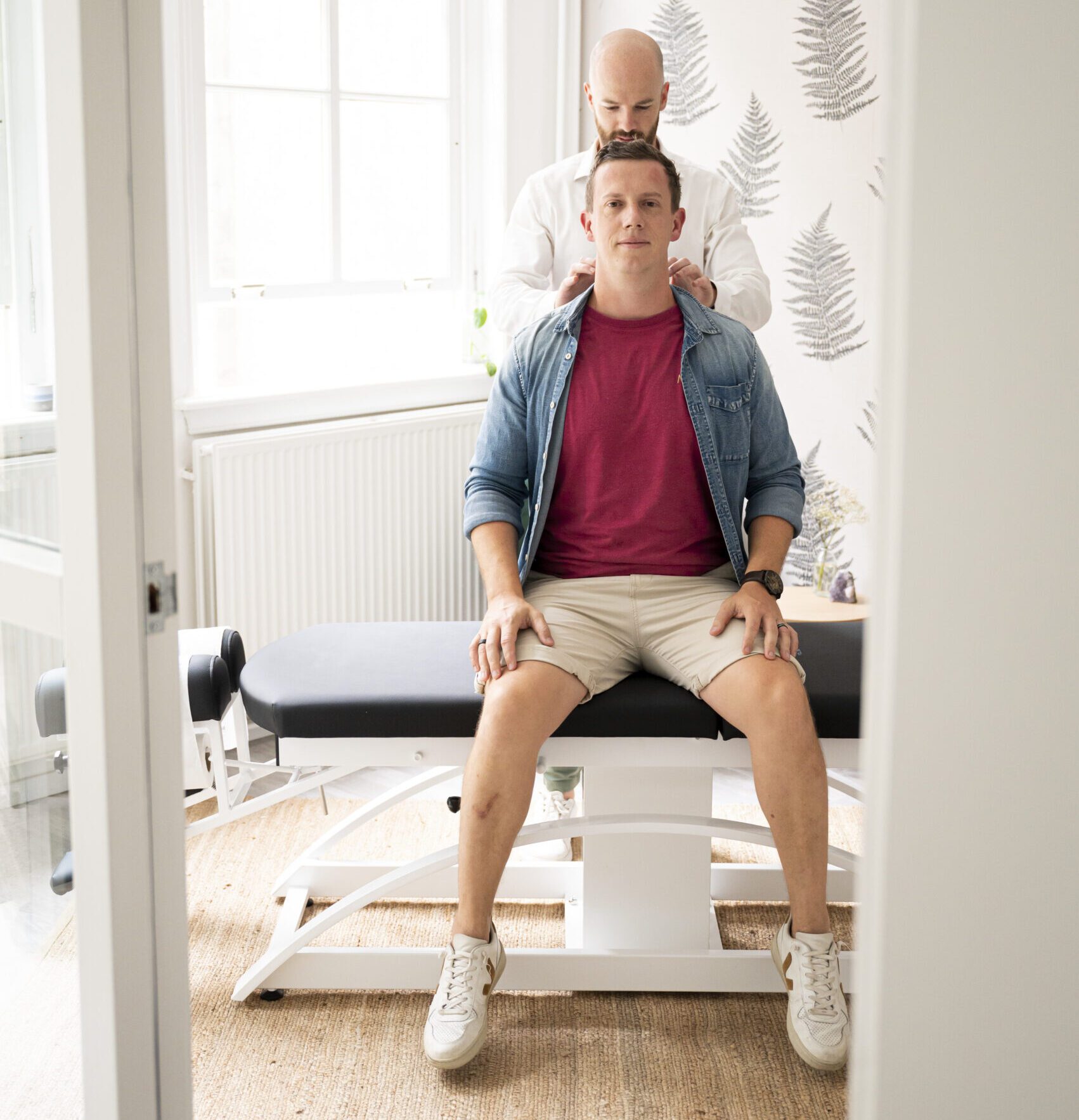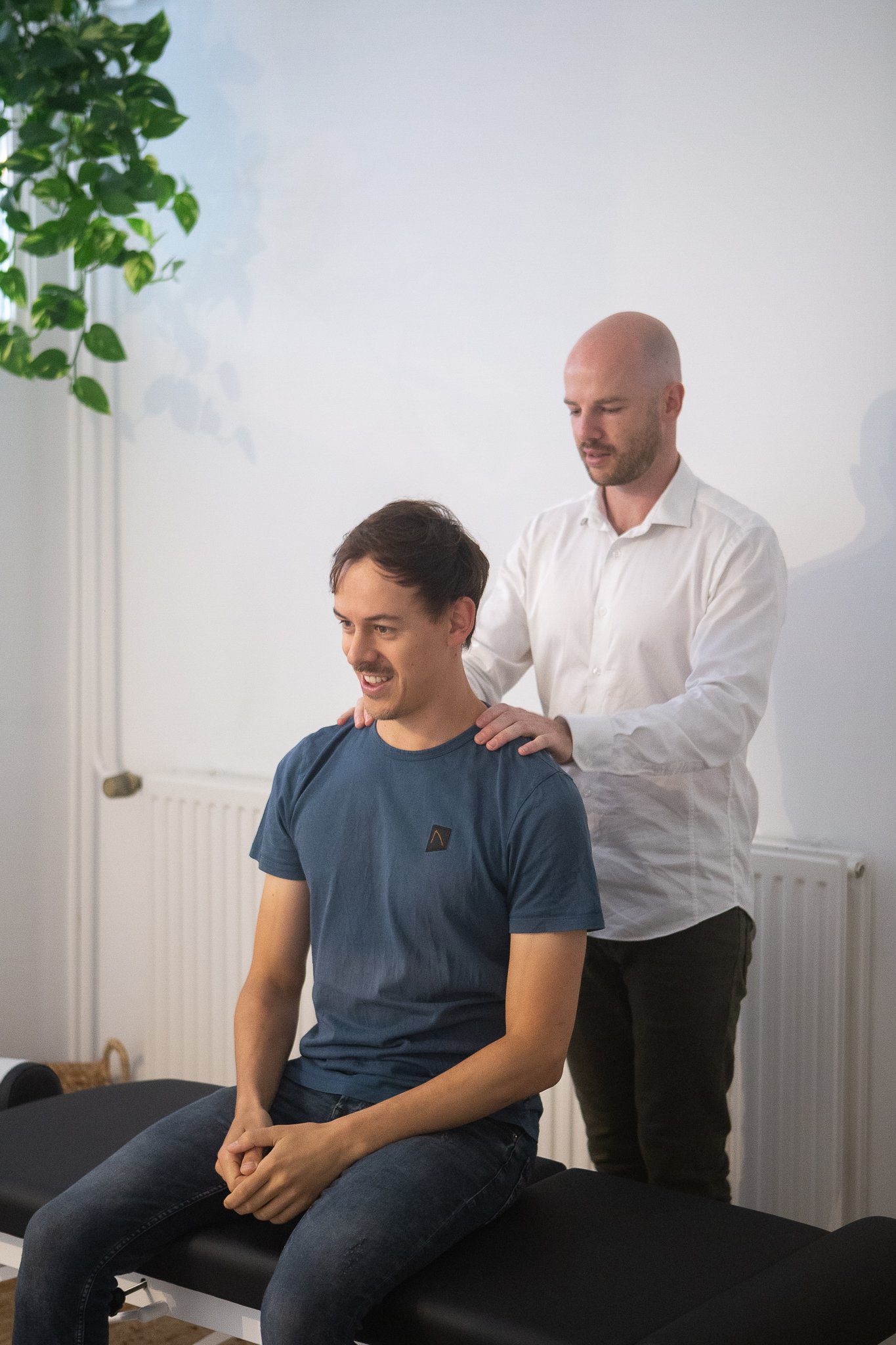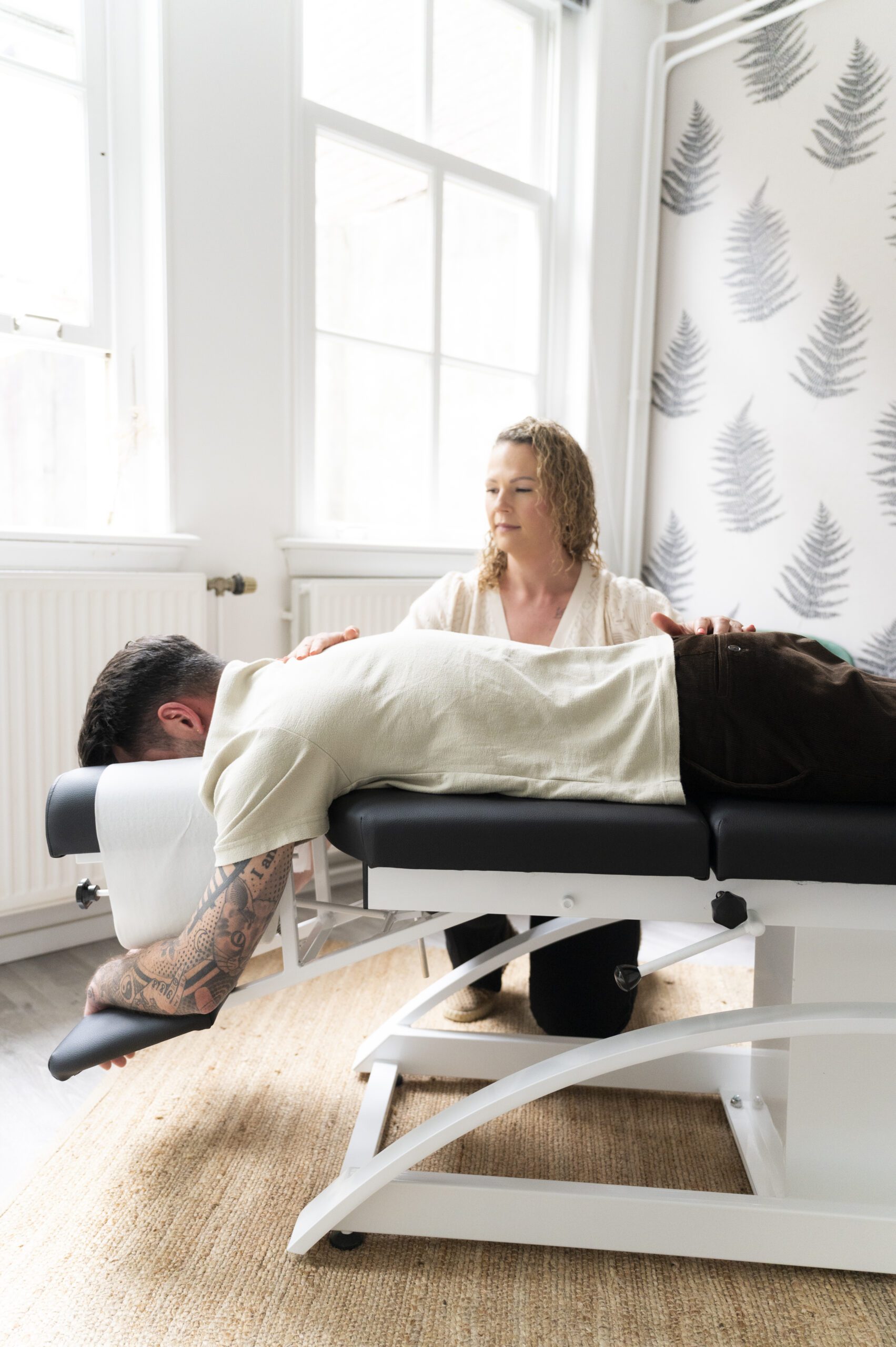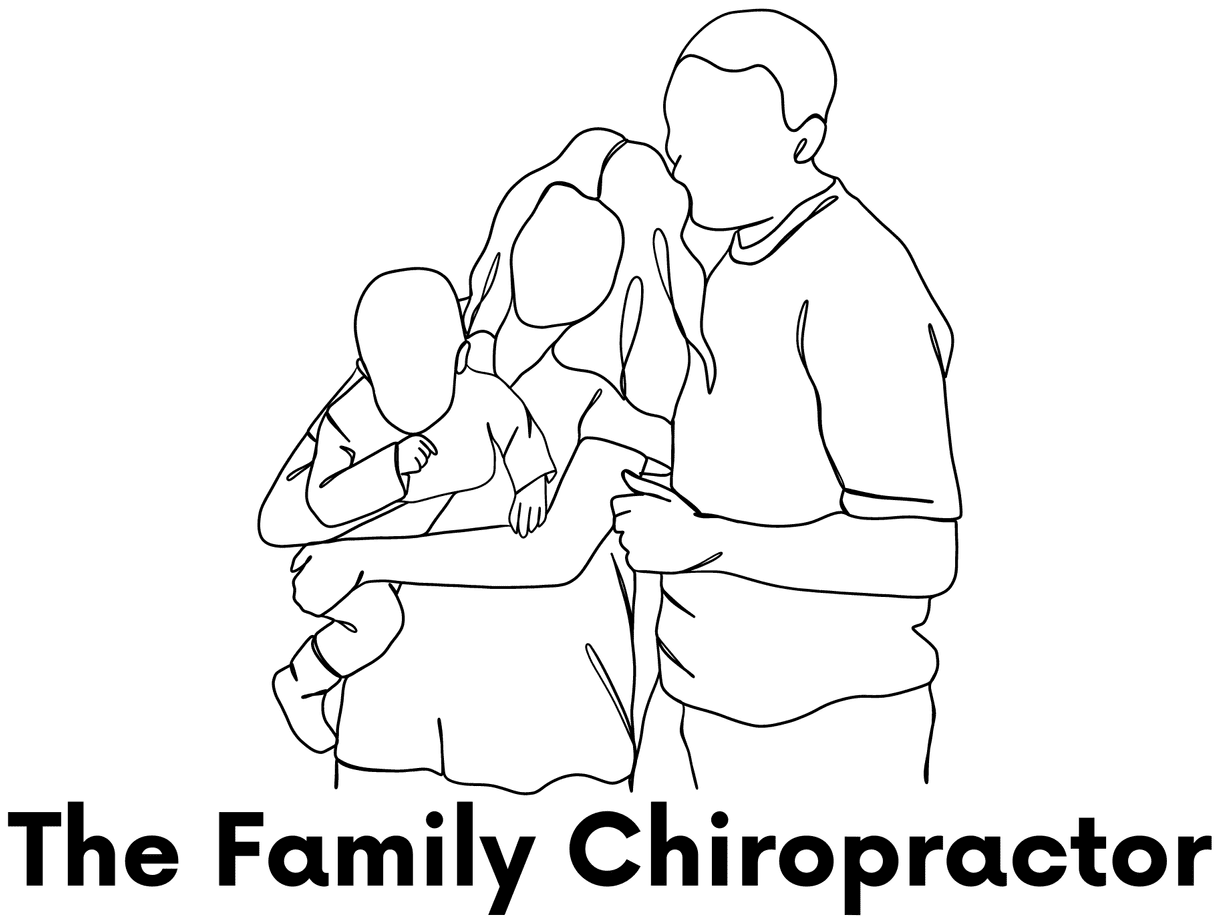Chiropractor for Frozen Shoulder
A chiropractor offers an effective and natural approach to relieve frozen shoulder symptoms and restore shoulder mobility.
Home » Who we help » Chiropractor frozen shoulder
Chiropractor for Frozen Shoulder

Frozen shoulder treatment at a chiropractor's office
Chiropractic care can help reduce pain by relieving pressure on nerves and improving the overall health of the spine and shoulder joints.
Chiropractors use various techniques to increase the range of motion of the shoulder. This can help reduce stiffness and restore movement of the shoulder.
Through the so-called 'chiropractic adjustments', chiropractors can improve blood circulation and lymphatic drainage, which can help reduce inflammation and swelling in the shoulder.
A chiropractic adjustment can also focus on reducing muscle tension and improving the balance of the muscles around the shoulder joint. This can contribute to faster recovery time and less pain and discomfort.
Chiropractors take a holistic view of health, meaning they do not focus on individual syptoms, but on the body as a whole. This means they also pay attention to other parts of the body that may affect the shoulder, such as the neck and upper back.
Chiropractic care is personalised. The chiropractor will create a personalised treatment plan specific to your unique needs, situation and medical history.
Chiropractic adjustements are non-invasive and do not require medication, which is important for people looking for natural treatment options or who want to avoid side effects of medication.
The benefits of a chiropractor for headaches
- Pain relief
- Improved freedom of movement
- Anti-inflammatory effects
- Reducing muscle weakness
- Holistic approach
- Individual treatment plan
- Non-invasive and medication-free


What is frozen shoulder?
A frozen shoulder, also known as adhesive capsulitis, is a condition in which the shoulder becomes stiff and painful and the range of motion is significantly reduced. This condition usually develops gradually and worsens over time. The condition is characterised by inflammation, thickening and adhesion of the joint capsule surrounding the shoulder joint, resulting in movement restriction and pain.
Stages and symptoms of frozen shoulder
The symptoms of frozen shoulder usually develop gradually and can be divided into three phases. These phases can extend over a period of months to years. It is important to see a healthcare professional if you experience symptoms of a frozen shoulder, as early intervention can help relieve symptoms and shorten recovery time.
Freezing phase (Frozen phase):
- Pain: pain starts gradually and can be severe, especially at night. It may be difficult to lie on the affected shoulder.
- Stiffness: as the pain increases, the shoulder also starts to get stiffer.
- Movement restriction: freedom of movement of the shoulder begins to decrease, especially when lifting the arm above the head or bringing the arm behind the back.
Frozen phase (Freezing phase):
- Pain reduction: pain may decrease slightly, but stiffness remains or worsens.
- Severe stiffness: The shoulder becomes increasingly stiff, making daily activities such as dressing, reaching and lifting difficult.
- Restricted movement: Freedom of movement is severely restricted in all directions.
Thawing phase:
- Pain relief: Pain gradually decreases.
- Stiffness decreases: Freedom of movement slowly begins to return.
- Improvement in mobility: The shoulder begins to function normally again, although full recovery time may take several months to a year.
Causes of frozen shoulder
The exact causes of frozen shoulder are not always clear, but there are some risk factors and conditions that can increase the likelihood of developing this condition
Risk factors for Frozen Shoulder
People aged between 40 and 60 are at higher risk of developing a frozen shoulder. Women are also more likely to develop a frozen shoulder than men. A sedentary lifestyle and lack of physical activity can increase the risk, as can being overweight and obese. In addition, there are several health conditions in which the risk of a frozen shoulder is increased. Both rheumatoid arthritis and osteoarthritis can increase the risk of a frozen shoulder. Chronic lung conditions such as tuberculosis and other infections can also contribute to the risk. People with diabetes, both type 1 and type 2, have an increased risk of developing a frozen shoulder, both with hypothyroidism (underactive thyroid) and hyperthyroidism (overactive thyroid). People with Parkinson's disease are also more likely to develop a frozen shoulder.Finally, cardiovascular diseases and certain heart surgeries can also be a risk factor.
Relationship between immobilisation and Frozen Shoulder
Prolonged immobilisation (=not moving) of the shoulder, for example after surgery, injury or fracture, can increase the risk. This is for example if the shoulder has been in a sling or cast, or after a stroke where the arm is used less. Shoulder injuries, such as trauma or inflammation in the shoulder joint, can also contribute to the development of frozen shoulder.


Frozen Shoulder: cause stress
How a chiropractor can help with frozen shoulder
What is chiropractic
Chiropractic focuses on removing blockages in the spine to optimise the functioning of the nervous system. The nervous system is your body's communication system: it is the connection between your brain and the rest of your body. The nervous system is protected by the spine. If there is a blockage in the spine, your nervous system cannot communicate and perform optimally, which can manifest itself in all kinds of different complaints. By releasing the blockages in the spine, the nervous system can once again do its work better and the body itself can take care of healing and resolving complaints.
Chiropractic techniques for frozen shoulder
When treating a frozen shoulder, chiropractors can apply various techniques to reduce pain and improve shoulder mobility. Chiropractors apply gentle corrections, called 'chiropractic adjustments', to the shoulder joint to improve mobility. These manipulations help reduce stiffness and increase range of motion. Mobilisation techniques, which involve passive movement of the joint, can also help improve flexibility and relieve pain. Chiropractors also use various techniques to relax tense muscles around the shoulder. This can help reduce pain and increase range of motion.
Improper posture can also contribute to the development of a frozen shoulder. Chiropractors will help you improve your posture and reduce the strain on the shoulder. They may also recommend certain stretching and strengthening exercises to gradually restore shoulder motion.
Chiropractic care for frozen shoulder cause stress
Chiropractic offers effective treatments for people suffering from frozen shoulder, and especially when the underlying cause of the frozen shoulder is stress. Because chiropractors work with the nervous system and balance the entire nervous system, it does a lot with your body's stress-management ability. Recognising stress as a cause of frozen shoulder and addressing it through chiropractic care can be an effective way to relieve symptoms and restore mobility.
Chiropractors understand the complex relationship between stress and how it can manifest itself in a variety of physical complaints, including frozen shoulder.
Chiropractic care is therefore aimed at providing relief and improving your overall well-being, taking a holistic view of all the components that may be involved.

Are you ready to improve your health yet!
Sleep position frozen shoulder
Besides your visit to a chiropractor, there are some additional things you can do yourself at home to help your recovery. Below, we tell you more about the best sleeping position for frozen shoulder and describe frozen shoulder exercises you can do at home.
Correct sleeping position Frozen Shoulder
A frozen shoulder can cause a lot of discomfort and pain at night when you are trying to sleep. Finding the right sleeping position for frozen shoulder is very important. Not only because it minimises the pain at night, but also because it improves the quality of your sleep, which also allows your body to recover better. Below, we discuss some tips that can help you sleep with frozen shoulder.
1. When sleeping on your back
- Use a pillow under your arm: place a pillow under the arm of the affected shoulder to keep it in a comfortable and supported position.
- Support your neck: make sure your neck is well supported by an appropriate pillow that maintains the natural curvature of your spine.
2. Sleep on your unaffected side
- Place a pillow between your arms: this helps keep your shoulders in a neutral position and prevents the frozen shoulder from 'rolling' forward.
- Use a body pillow or pregnancy pillow: a body pillow can provide extra support and help you stay in a comfortable position during the night.
3. Sleeping in a semi-seated position
- Use multiple pillows: stack pillows behind your back to support you in a semi-sitting position. Should you have an adjustable bed, this can also be a very nice option.
Choosing the right sleeping position for frozen shoulder can make a world of difference. Whether you sleep on your back, on your unaffected side or in a semi-seated position, the goal is to support the frozen shoulder and reduce pressure. If you have persistent problems or questions, it is advisable to consult your chiropractor for further advice.


Frozen Shoulder exercises
Exercises for frozen shoulder can help improve shoulder mobility and reduce pain. It is important to start with mild exercises and gradually increase the intensity. Here are some exercises you can do:
1. Pendulum Exercise
- **Beginning position**: Stand with your healthy arm leaned on a table or chair, let the affected arm hang down relaxed.
- **Execution**: Slowly move your arm in small circles, first clockwise and then anti-clockwise.
- **Repetitions**: 10 times in each direction, 1-2 times a day.
2. Towel Stretch
- **Beginning position**: Standing with a towel behind your back, hold one end of the towel above your head with your healthy hand and the other end with your affected hand.
- **Implementation**: With your healthy hand, gently pull up the towel, pulling your affected arm upwards.
- **Repetitions**: Hold the stretch for 15-30 seconds, repeat 5 times.
3. Finger Walk
- **Beginning position**: Stand in front of a wall at arm's length, with your fingers of the affected hand against the wall.
- **Execution**: "Walk" slowly up the wall with your fingers until you can't go any further without pain. Then slowly walk down again.
- **Repetitions**: 10-20 times a day.
4. Cross-Body Stretch
- **Beginning position**: Standing or sitting upright, bring your affected arm straight out in front of you.
- **Execution**: Use your healthy arm to pull your affected arm across your body, towards your opposite shoulder.
- **Repetitions**: Hold the stretch for 15-30 seconds, repeat 5 times.
5. Doorway Stretch
- **Beginning position**: Stand in a doorway with your arms bent at 90 degrees, elbows at shoulder height and hands against the doorframe.
- **Execution**: Slowly step forward with one foot until you feel a stretch in your chest and shoulders.
- **Repetitions**: Hold the stretch for 15-30 seconds, repeat 5 times.
6. Internal Rotation
- **Beginning position**: Stand with your back against a wall, holding a resistance band in both hands, with your elbows against your sides and bent at 90 degrees.
- **Execution**: Turn your affected arm inwards against the resistance of the band, keeping your elbow against your side.
- **Repetitions**: 10-15 times, 1-2 times a day.
7. External Rotation
- **Beginning position**: Stand upright with your elbows bent at 90 degrees and your arms against your sides, holding a resistance band in both hands.
- **Execution**: Turn your affected arm outwards against the resistance of the band, without moving your elbow from your side.
- **Repetitions**: 10-15 times, 1-2 times a day.
8. Sleeper Stretch
- **Beginning position**: Lie on your side with your affected shoulder under you, your arm bent at 90 degrees and your hand extended forward.
- **Execution**: Use your healthy hand to push your forearm down towards the floor until you feel a stretch in the back of your shoulder.
- **Repetitions**: Hold the stretch for 15-30 seconds, repeat 5 times.
Doing these exercises can help improve the mobility of your shoulder and reduce pain. Patience and consistency are essential in recovering from a frozen shoulder.
Frozen shoulder treatment at The Family Chiropractor
A frozen shoulder can significantly hamper your daily life, but there is no need to keep walking around with the pain and restrictions. At The Family Chiropractor, we understand how important it is to be able to move freely again without pain. Our experienced and certified chiropractors are ready to help you every step of your recovery process. With a personalised and holistic approach, we focus on relieving your pain, improving your mobility and restoring the functionality of your shoulder.
Come in for frozen shoulder treatment at The Family Chiropractor today and take the first step towards a pain-free and active future. Still have questions? Then contact us or book a free introductory consultation, and experience for yourself the benefits of chiropractic care for your frozen shoulder!

Meet our chiropractors

Dr Cherie Dryden Schofield Wright
Cherie is passionate about chiropractic care for the whole family, with a special interest in pregnancy and postpartum care for mothers and babies.

